Why Pine Straw Mulch
Longleaf Pine Straw Mulch Specifications
Besides the environmental benefits, pine straw mulch also:
- Insulates tender roots from temperature extremes, in turn, keeping the soil warm during cold spells and, conversely, cool during hot spells.
- Conserves soil moisture by reducing water evaporation rates and moisture loss.
- Encourages water infiltration into the soil and reduces runoff.
- Eliminates erosion caused by wind and rain-splash impact.
- Protects against soil compaction by reducing the rain impact directly on the surface.
- Aids in promoting favorable soil balance for healthy root growth.
- Does not have to be removed. All you need do is put fresh straw on the top of old straw to revitalize the color and provide beds with new nutrients.
- Act as RENEWABLE RESOURCE
Quick Facts:
Appearance: Good to Excellent
Insulation: Good
Cost: Average (equal to in cost when comparing with premium hardwood bark mulches)
Thickness: 2” – 3”
Weed Control: Good
Water Penetration: Excellent
Moisture Retention: Good
Decomposition Speed: Slow
Durability: Good (outlasts other mulches because of resin content)
Comments: Often used with acid-soil plants
“Renewable Resource” and “Sustainability“…What are these words we are hearing so much about these days? Renewable resources are things on earth that can grow/reproduce again and again, and never run out (i.e. air, water, trees). Sustainability is, “Meeting the needs of the present without depleting resources or harming natural cycles for future generations”. It is all of our civic and moral duty to protect our earth and use products that are a Renewable Resource and contribute to the environment’s sustainability. The more demand that is generated for Pine Straw Mulch, the more Longleaf Pine Trees will be planted to supply this demand. Trees are not harmed or destroyed when harverting Pine Straw, as the needles are shed from the tree, fall to the ground and are raked and baled by hand. This is one of the reasons is why Pine Straw is the one of the most ecologically and environmentally friendlychoices when choosing a mulch.
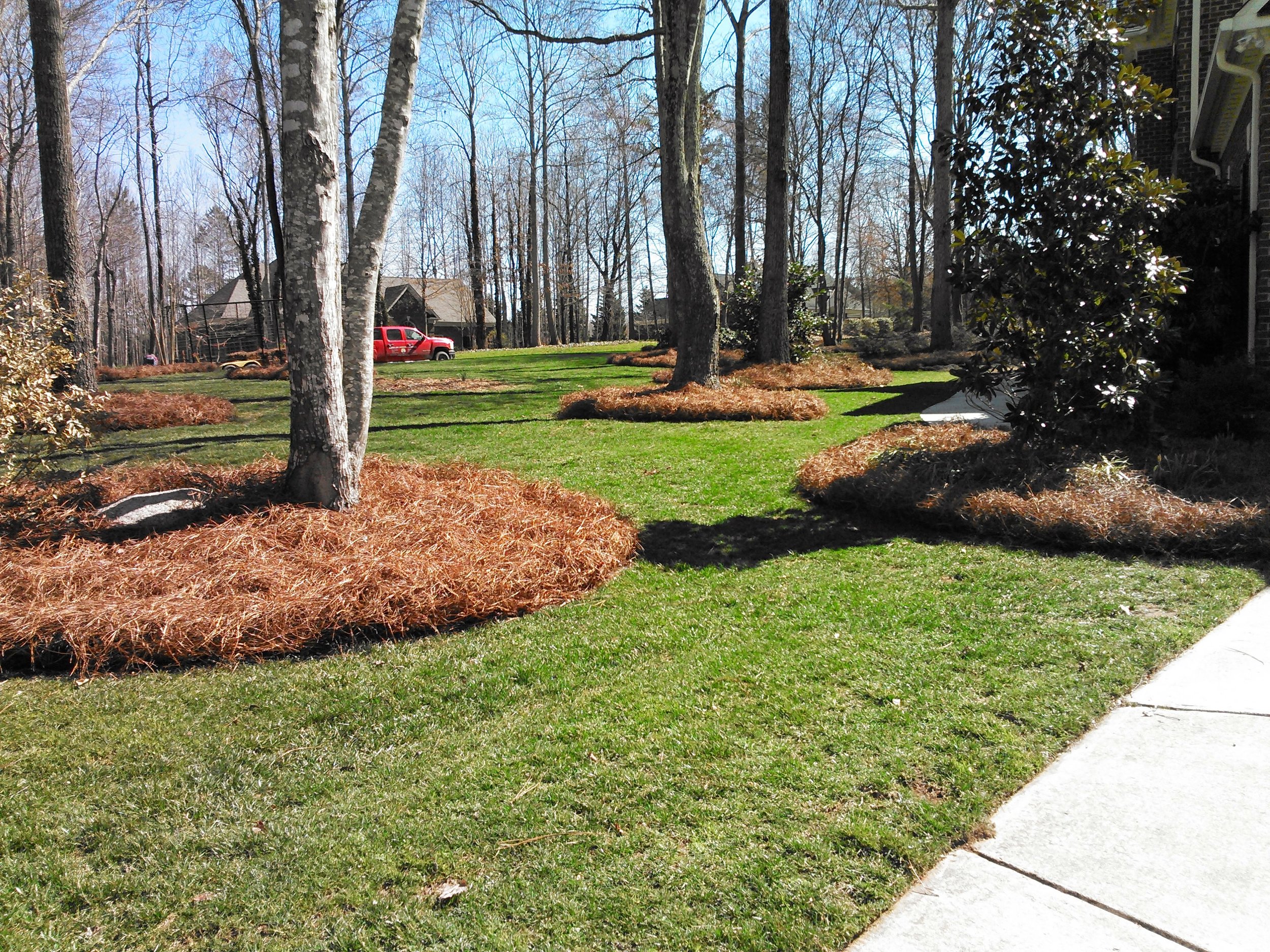
Why Use Premium Longleaf Pine Straw Mulch
Benefits of Pine Straw Mulch
Pine straw has been a popular landscape ground cover throughout the South for the past 25 years. It is one of the most widely used mulches for all size projects from residential flowerbeds to industrial complexes and highway landscapes. Longleaf Pine Straw is an asthetically appealling reddish/brown mulch that can be used in a variety of landscapes to enhance the texture, color, contrast, weed-deterrent capabilities and uniqueness of your landscaping. The fine texture and uniform color of pine straw is more aesthetically pleasing to some people than traditional wood bark mulch.
Mulches act as a catalyst in creating favorable growing conditions for plants. In other words, Pine Straw helps create the necessary environment to stimulate healthy plant development. Pine Straw promotes uniform plant growth and slowly decomposes to release organic nutrients that enrich the soil. Insulation is a key Pine Straw characteristic, and as a result, a plant’s root system and the lower stems of plants stay cooler in warm weather and remain warmer in colder weather. A layer of Pine Straw helps keeps the roots of tender plants from freezing.
Pine Straw interlocks and holds together during hard rains and heavy winds, even on sloping landscapes. Because Pine Straw interlocks, pine straw will not wash out of beds like other mulches. Whereas many mulches do not allow water to runoff (rain and/or irrigation), pine straw allows water to flow through it to the soil underneath. The same quality by which pine straw allows for water to flow through it also helps to conserve soil moisture by reducing water evaporation rates and moisture loss. Pine straw also has the added benefit of reducing erosion caused by wind and rain-splash impact and adhering well to slopes; thus, not washing away as easily as other mulches during heavy rain.
Pine needle mulch (pine straw) is the number one mulching material used in landscape plantings in the Southeastern U.S. Because pine straw is actually a leaf (needle), it benefits the environment in the same way that decomposing leaves benefit the forest floor, by recycling nutrients and maintaining soil organic matter in a compost-like fashion. NO Trees are destroyed in the process of harvesting pine needles. The carbon footprint for harvesting pine needles vs. other mulches is very low. The majority of pine needle harvesting is done so by hand by manually using a rake. The pine straw is raked into piles, and then placed into a wooden box for baling.
How to buy Pine Straw:
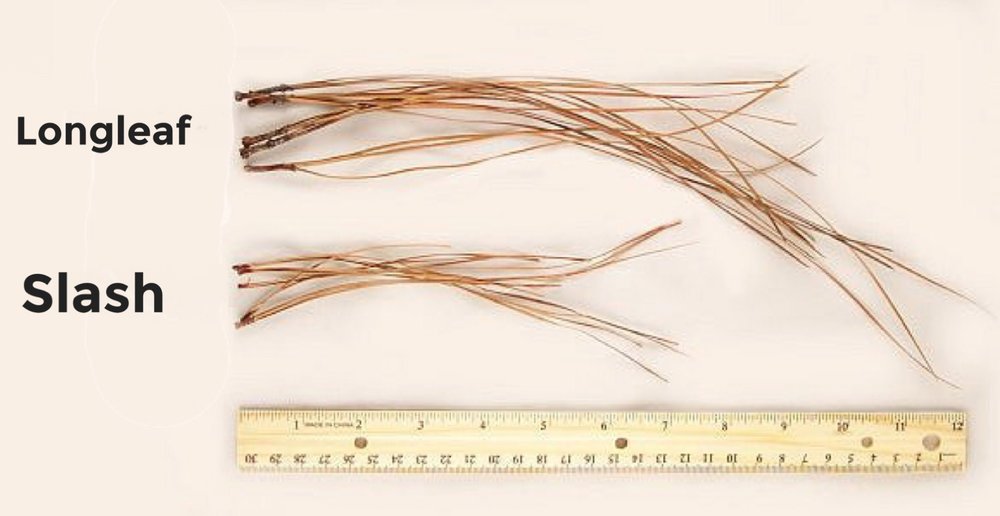
We sell only premium Longleaf Pine Straw Mulch. Oftentimes, pine straw types are misconstrued by the consumer and misrepresented by the seller. Inferior pine straw mulch is often referred to as “Slash” or “Long needle” and is often misrepresented as “Longleaf”. Watch for the wording ‘long needle’ –long needle is NOT the same as Longleaf. If you ask a seller, “What type of pine straw do you sell?” and the answer is “I don’t know” or “It’s Pine Straw”, this is a red flag and you should be concerned as you may be getting an inferior product.
There is no set industry standard for pine straw bale size. The dimensions and weight of the bale are the most important attributes to consider. Do not rely on the square footage claim the company makes as this will vary greatly depending on the depth at which the pine straw is installed. If you compare two bales, equal in size, one supplier may claim their bale covers a larger square footage than another bale of equal size and yet they cover the same area but at a varied depth. These two bales will, in fact, cover the same square footage if installed at equal depths. Some companies tend to exaggerate their square footage claims (by spreading the pine straw thinner over a wider area) in order to make their product look cheaper in price.
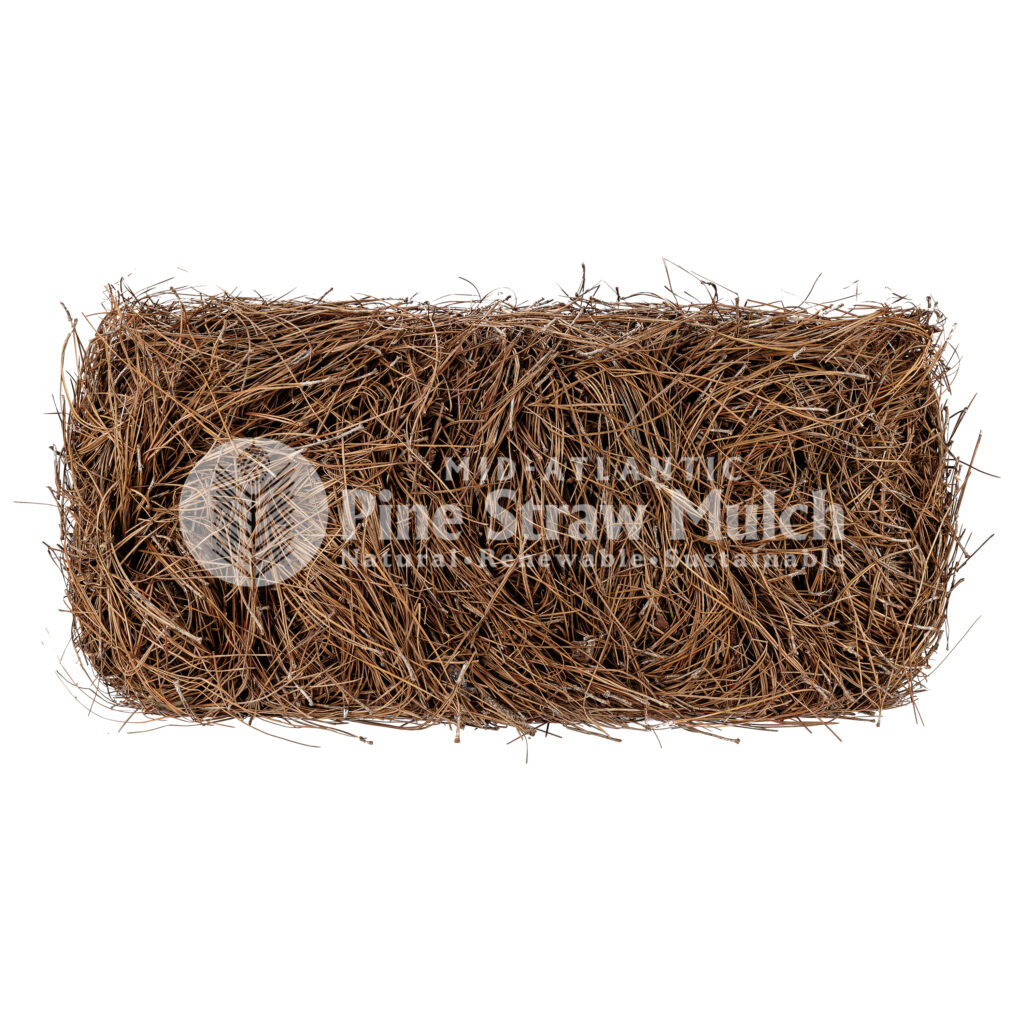
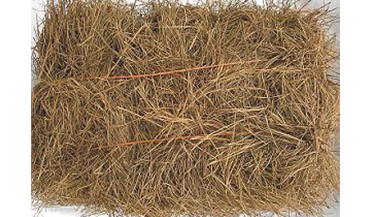
Why Buy from Mid-Atlantic Pine Straw
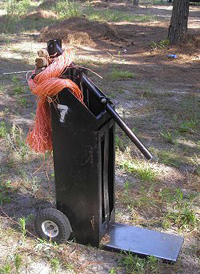
Where and How is our Pine Straw Sourced
- All of our product is inspected, before being transported, to ensure that non-invasive species are not present. Each load we ship from South Carolina is inspected by a Clemson University Invasive Species Coordinator to ensure that we are in compliance with both Federal and State rules for the shipping of nursery stock.
- Our focus is ONLY on Pine Straw. Therefore, we turn over our product monthly, which allows our customers to receive the ‘freshest’ pine straw. You won’t receive last years’ pine straw or pine straw that has been sitting on a tractor trailer for a year from our company. Our pine straw is protected from the elements and kept dry once it is baled and ready for sale.
- We source directly from designated Longleaf plantations where the pine straw is hand-raked and hand-baled. This allows us to obtain only the highest quality longleaf pine straw. Hand-raking and hand-baling also reduces the amount of forest debris and sticks.
- Our customer service will exceed your expectations. We form long-lasting relationships with our customers. We are a family-owned and operated business and involved with pine straw since 2007.
The Pine straw we source is harvested in South Carolina. The pine straw is hand raked on designated property.
Each raker works a section of the field where they will assemble a pile of pine straw. From this pile, the raker will pick-up with two handfuls of pine straw and shake the straw to remove any debris. The the pine straw is then placed in the metal or wooden boxes (“balers”) which are shown below. The pine straw is then compressed into the box and tied with two strings to secure the bale. At the end of each day, the bales are placed into a trailer for storage. Pine straw is raked year round to ensure that our pine straw mulch supply is fresh. The trailer is then loaded and ready to transport to us here in Pennsylvania. The below videos and pictures were taken to help educate our customers about pine straw. People often ask, “Where does pine straw come from?”. The answer: In South Carolina, as well as the Sand Hills of North Carolina where large tracts of Longleaf Pine Trees reside.

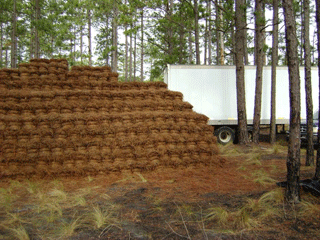
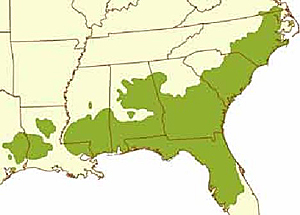
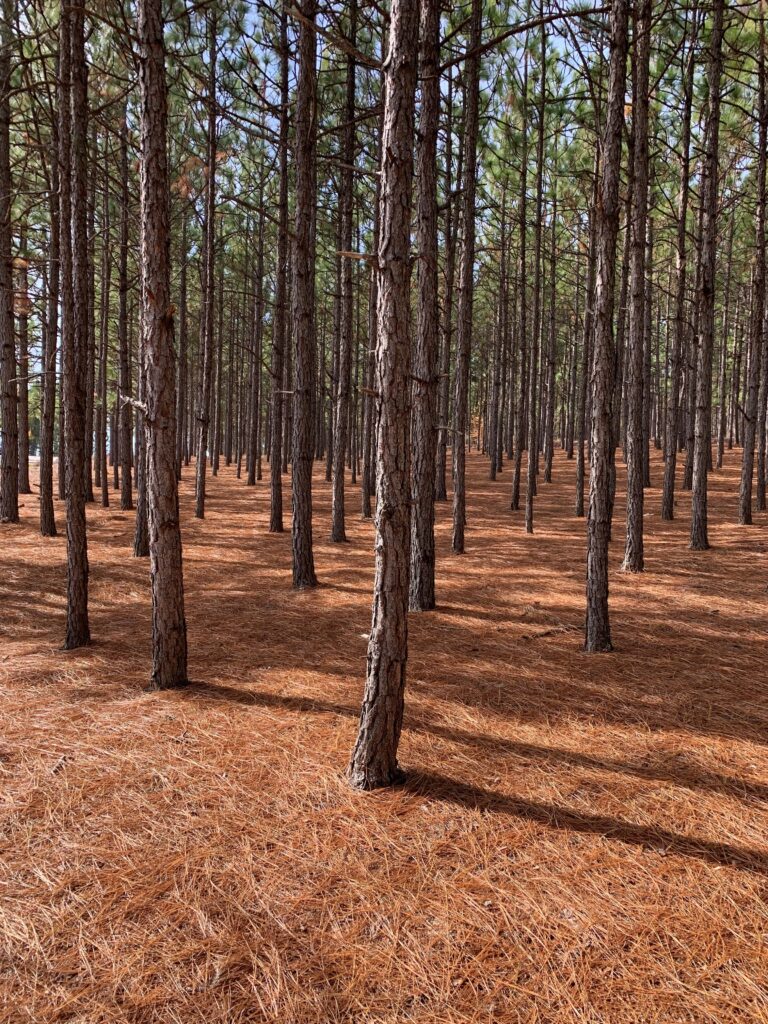
Environmental Conservation
The Environmental Conservation Mulch – Reading online (http://www.conserve-energy-future.com/methods-and-importance-of-environmental-conservation.php) this defintion, it became very clear that Pine Straw is a mulch that meets this defenition.
So, What Exactly is Environmental Conservation?
There is much to do when it comes to rebuilding and protecting what’s left of natural resources and the biodiversity within our ecosystems. Environmental conservation is an umbrella term that defines anything we do to protect our planet and conserve its natural resources so that every living thing can have an improved quality of life. The forests that provide Longleaf Pine Needles produce clean air, clean water and countless wildlife benefits.
Environmental conservation comes in many forms and reminds us to be mindful of daily choices. No matter how busy your life may be, it remains fairly easy to make small, yet necessary, changes for the good of the Earth. If we all took little steps, we would make our way towards major progress. This can be achieved by paying more attention to what we buy and not using resources unnecessarily. Pine Straw Mulch is both renewable and substainable. Renewable because the pine needles are naturally replenised by the falling of new pine needles annually or bi-annually. Substainable becuase the long leaf pine forest eco-system maintains is owns viability and as demand for Pine Straw increases as its introduced into more northern climates, the need for more longleaf pine forest acreagae will be required to substain the need for more pine straw. Long Leaf Pine forest eco-systems are one of the most biologically diverse on the plant.
The environment is vital to our well-being and every element should be protected.
Consider every part of the environment, including the trees, the oceans and the soil. The trees that help us to breathe also isolate greenhouse gases that would cause the Earth to heat up more quickly. They hold soil in place and naturally filter water that has been absorbed into the ground.
Finally, the soil stands as its own supporter of life by acting as a supplier of food and a filter of water. Soil that is of good quality produces crops that feed humans and animals. Plants and flowers sprout up from the ground through the soil, helping to regulate our climate. Most of nature’s water isn’t made for human consumption, but soil also stores groundwater and filters it, making it safe for drinking.
The trees, the seas, and the ground; these three elements are necessary for our existence, and there are still more parts of nature that we need to protect. This is why there are a large number of conservationists, many of which have dedicated themselves to protecting specific causes. No trees are destoyed to supply Pine Straw, actually, more trees are planted to provide Pine Straw.
If every household incorporated the concepts of sustainable living by using less and conserving more, the positive impact would be immeasurable.
Help to replenish what is being taken away by giving back to the Earth. Use Pine Straw as your mulch of choice to support the environment.
Deforestation continues to be a major environmental issue. Many forests are losing countless acres of valuable trees, and because these trees are destroyed, the greenhouse gases they were storing go back into the atmosphere and contribute to global warming. Animals and people lose their food supply and homes, and the economic status of a region can also change because less forests often leads to less employment opportunities in the area.
Planting trees is a way to give back because it aids in the restoration of homes for wildlife, food sources, and medicinal properties that only the trees provide. As trees grow, they protect soil from harsh weather conditions and protect us from excess carbon dioxide, enabling us to live longer and more comfortably.
As a consumer you can make the decision to use Pine Straw in your landscaping, all the while helping the USDA with their Long Leaf Pine Restoration Initative to re-establish the Longleaf Pine Tree across its historic range.
